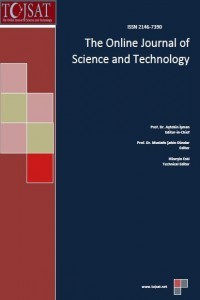DEMONSTRATION OF AN ELECTROSPRAY INJECTION SYSTEM
DEMONSTRATION OF AN ELECTROSPRAY INJECTION SYSTEM
Electrosprey, injection system,
___
- Bocanegra R., Galan D. Marquez M., Loscertales I.G., Barrero A., (2005), “Multiple electrosprays emitted from an array of holes”, Journal of Aerosol Science, 36, 1387-1399
- Cloupeau, M. and Prunet-Foch, B. (1994), “Electrohydrodynamic spraying functioning modes: a critical Review”, Journal of Aerosol Science, 25, 1021.
- Deng, W., Klemig, J.F., Xiaohui,L., Reed, M.A., Gomez,A., (2007), “Liquid Fuel Microcombustor Using Microfabricated Multiplexed Electrosprey Sources”, Proceedings of the Combustion Institute, 31, 2239-2246.
- Deng, W., Waits, C.M., Morgan, B., Gomez, A., (2009), “Compact Multiplexing of Monodosperse Electrosprays”, Aerosol Science, 40, 907-918.
- Dole, M., Mach, L.L., Hines, R.L., Mobley, R.C., Ferguson, L.D., Alice, M.B., (1968), “Molecular Beams of Macroions”, J. Chem. Phys., 49, s. 2240-2247
- Fenn, J. B., Mann, M., Meng, C.K., Wong S.F., Whitehouse, C.M., (1989), “Electrospray Ionization for Mass Spectroscopy of Large Molecules”, Science, 246, 64-71
- Fernandez de la Mora, J. (1992),” The effect of charge emission from electrified liquid cones”, J. Fluid Mech. 243, 561–574.
- Fernandez de la Mora, J., Loscertales I. G. (1994), “The current emitted by highly conducting Taylor cones”, J. Fluid Mech., 260, 155-184
- Javorek A. (1998), “Main modes of electrohydrodynamic spraying of liquids”, Third International Conference on Multiphase Flow, Lyon, France. Retrieved from: http://www.imp.gda.pl/fileadmin/old_imp/ehd/lyon-98s.pdf
- Krpoun, R. (2009), “Micromachined Electrospray Thrusters for Spacecraft Propulsion” (Doctoral dissertation), École Polytechnique Fédérale de Lausanne
- Lozano P., Martinez-Sanchez M., (2003), “Studies on the Ion-Droplet Mixed Regime in Colloid Thrusters” (Doctoral dissertation), Massachusetts Instutude of Technology
- Macky, W. A. (1931), “Some investigations on the deformation and breaking of water drops in strong electric fields”, Proceedings of the Royal Society of London. Series A 133(822), 565–587.
- Smith, K. L., (2005), “Characterization of Electrospray Properties in High Vacuum with a View to Application in Colloid Thruster Technology”, (Doctoral dissertation), University of London
- Tang K., Lin Y., Matson D. W., Kim, T., Smith R.D., (2001), “Generation of Multiple Electrosprays using microfabricated emitter arrays for improved mass spectrometric sensitivity”, Anal. Chem., 73, 1658-1663
- Taylor, G. (1964), Desintegration of water drops in an electric field, Proceedings of the Royal Society of London. Series A, Mathematical and Physical Sciences 280(1382), 383–397.
- Velasquez-Garcia, L. F., Akinwade, A. I., Martinez-Sanchez, M., (2006), A Micro-Fabricated Linear Array of Electrospray Emmiters for Thruster Applications, Journal of Microelectromechanical Systems, 15, 1260-1271
- Velasquez-Garcia, L. F., Akinwade, A. I., Martinez-Sanchez, M., (2006), “A planar array of micro-fabricated electrospray emitters for thruster applications”, Journal of Microelectromechanical Systems, 15, 1272-1280
- Valesques-Garcia BGLF, Akinwande, A., Martinez-Sanchez, M., (2008), Fabrication of a Fully Integrated Electrospray Array with Applications to Space Propulsion, 21st IEEE International Conference on Micro Electro Mechanical Systems (MEMS 2008), 976-979.
- Zeleny, J. (1914), The electrical discharge from liquid points and a hydrostatic method to measure electric intensity at their surface, Phys. Rev., 3, 69–91
- ISSN: 2146-7390
- Başlangıç: 2011
- Yayıncı: The association of science, education and technology
Simulation and Optimization of Ethyl Acetate Reactive Packed Distillation Process Using Aspen Hysys
Abdulwahab GIWA, Süleyman KARACAN
AN EMPRICAL INVESTIGATION OF CUSTOMER SATISFACTION
Fatma NOYAN, Gülhayat Gölbaşı ŞİMŞEK
EFFECT OF H2 REDUCTION ON CARBON NANOTUBE SYNTHESIS
Nazlı ÇINAR, Neslihan YUCA, Nilgün KARATEPE
DEMONSTRATION OF AN ELECTROSPRAY INJECTION SYSTEM
Mahmut Can Karakaya, M. Ragıp Abdullahoğlu, Onur Tunçer, Hüseyin Kızıl, Levent Trabzon
Cercis IKİEL, Ayse Atalay DUTUCU, Beyza USTAOGLU, Derya Evrim KİLİC
EFFECT OF TWO LOBE WAVE SQUEEZE FILM DAMPER IN THE SUPPORT OF AN UNBALANCED RIGID ROTOR
Giovanni Adiletta, Erasmo Mancusi
INHIBITION ACTION OF LAWSONE ON THE CORROSION OF MILD STEEL IN ACIDIC MEDIA
S.h.s. DANANJAYA, M. EDUSSURİYA, A.s. DİSSANAYAKE
ASYMMETRIC ENCRYPTION / DECRYPTION WITH PENTOR AND ULTRA PENTOR OPERATORS
Artan LUMA, Bujar RAUFİ, Xhemal ZENUNİ
Modeling of Residual Stresses in TBC Coated Gas Turbine Blades
Yaşar KAHRAMAN, Sedat İRİÇ, İmdat TAYMAZ
